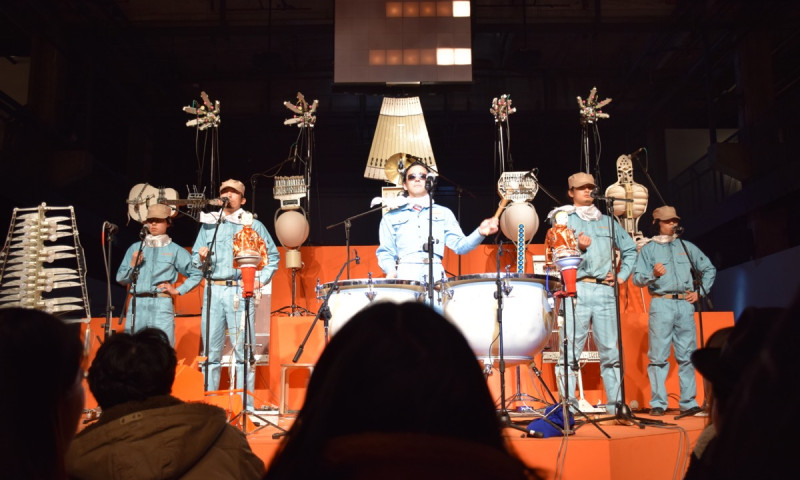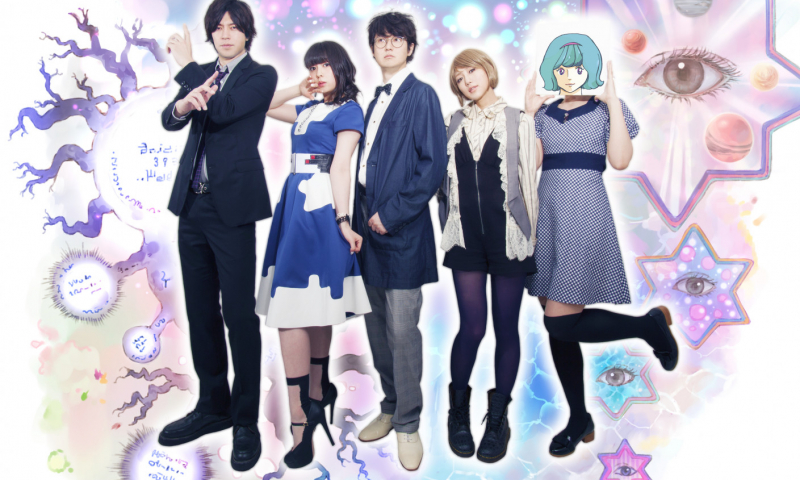
TOKYO CUTTING EDGE CREATORS by Julie Watai #11 featuring Frenesi: The Singer-Songwriting-Animator


Sponsored Links
TOKYO CUTTING-EDGE CREATORS by Julie Watai is column series, which covers Tokyo’s latest cutting-edge culture! In this series she’ll be interviewing creators that have caught her interest, in order to discover the latest cutting-edge culture in Tokyo. For our first installment, we interviewed artist Ai☆Madonna, and for the second time welcoming Junya Suzuki, who has been working for fashion label “chloma”, and for this time we will be interviewing artist Etsuko Ichihara, who has been creatingvery unique works.
東京の最先端カルチャーを常に追いかけ続けてきたJulie Wataiさんの連載『TOKYO CUTTING-EDGE CREATORS by Julie Watai』。この連載では、Julie Wataiが注目するクリエイターとの対談を通じ、新たな東京の最先端カルチャーを発見していきます。初回では愛☆まどんなさん、第2回目ではファッションレーベル”chloma”の鈴木淳哉さんにインタビューさせて頂きました。そして今回のゲストは、何かと話題のプロダクトを生み出し続けるアーティスト、市原えつこさんです。
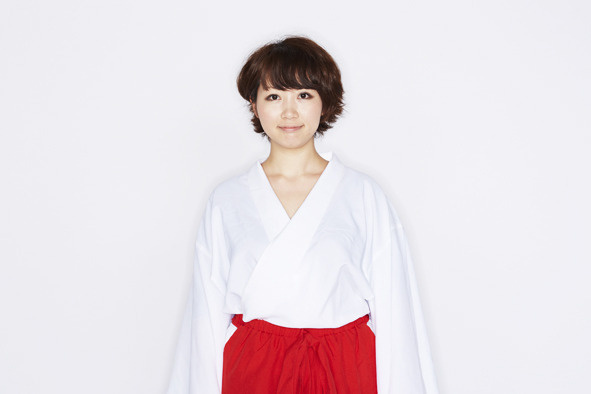
Etsuko Ichihara
Julie: Hello, and thank you for making time to chat with me today. I think there might be some readers out there who are just hearing your name for the first time as part of this series, so would you mind introducing yourself first?
Julie:こんにちは、対談よろしくお願いします。連載で初めて市原さんのことを知った方もいらっしゃると思いますので、まずは自己紹介をお願いしてもいいですか?
Etsuko Ichihara: Sure! I’m working as an artist in Tokyo, and am also a director of wild ideas! (laugh) I make things that combine unique aspects of Japanese culture with technology, and I’ve created things like the “Sexual Harassment Interface” with Japanese radishes that make sexy breathing noises when you touch them, and my most recent work, the “Digital Shaman Project”, which incorporates the familiar ideas of the Buddhist 49 days mourning ritual into a household robot.
市原えつこ: はい! 私は東京で活動しているアーティスト、そして「妄想監督」です(笑)! 日本独自の文化とテクノロジーを掛けあわせた作品づくりをしていて、日本の大根にセンサーを繋いで触るとセクシーな喘ぎ声を繰り出す「セクハラ・インターフェース」や、新作では日本の仏教の死生観で馴染みのある49日の考えを家庭用ロボットにインストールした作品「デジタルシャーマン・プロジェクト」などをつくっています。
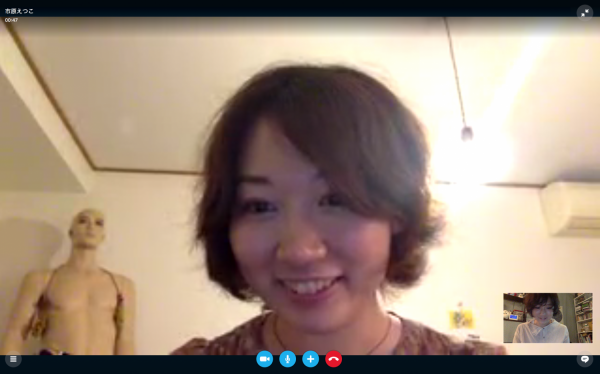
※The interview was taken through Skype video chat
Julie: The title of artist and “director of wild ideas” seems fitting. Even as an artist, I think it’s safe to say that your genre of work has already surpassed the boundaries of art and is something of your very own world.
Julie: 肩書きがアーティスト、「妄想監督」とは市原さんらしいというか。そうですね。アーティストとは言っても作品はジャンルの垣根を飛び越えていてもはや「市原さんワールド」と言えますね。あえてカテゴライズするとすればメディアアートの人なのかな?と思っていました。
Etsuko: I appreciate the compliment. Even I feel like I’ve lost myself considering the current field I’m exploring, but for convenience sake I like to refer to myself as an artist. I’m a total outsider when it comes to entertainment, research, art, and many other fields. (laugh) But if I were to give the current field I’m in a name, I’d say it’s close to media art. As far as the “director of wild ideas” goes, I often work together with technical directors, but the title first came about when I was directing myself and thought, “Hmm I wonder what kind of area would this fall under? Oh, I know! Something wild!!”
市原えつこ: そう言って頂けるとうれしいです。私も、自分がどの分野に入るのか迷子な感じがしていて、今は便宜的に「アーティスト」と言っています。エンタメ、研究、アート、いろんな分野のアウトサイダーです(笑)。そうですね、分野で言うと、メディアアートが近いと思っています。「妄想監督」というのは、私はテクニカルディレクターの方と一緒に制作することが多いんですが、では私がディレクションしているのはどの領域か? と考えた時に、「妄想だ!!」となって名乗り始めました。
Julie: I see; I can definitely see these wild ideas of yours represented in your work. You tend to work with other technical people as a unit, don’t you?
Julie: なるほど、市原さんの妄想を具現化したものが作品となって発表されている。テクニカルの人とはユニットで制作をされているんですよね。

Sekuhara Intaafeesu (Sexual Harassment Interface) セクハラ・インターフェース
Julie: Speaking of your work, I was initially shocked by your “sexual harassment interface”. The first time I saw it was while I was serving as a judge for the Electronic Works Contest (Denshi Kosaku Contest, which is now called Gugen) that was held at Arts Chiyoda (3331 Arts Chiyoda) in Akihabara, and the jury room was abuzz over the bold outline of your presence compared to the other electronic works there. Would it be fair to say that that was your first work as a director of wild ideas?
Julie:市原さんの作品といえば、最初に衝撃を受けたのが「セクハラ・インターフェース」。初めて見た時は秋葉原のアーツ千代田で開催された「電子工作コンテスト」で審査委員をさせてもらった時でしたが、他の電子工作作品とは明らかに一線を画す存在感で審査員室でも騒然となっていました。市原さんの妄想監督としての、最初の作品という認識で間違っていないですか?
Etsuko: That’s right, the sexual harassment interface was a collaborative effort with technical director Taiki Watai. Hearing you remind me of what happened there always brings a smile to my face.
市原えつこ: はい、セクハラ・インターフェースは渡井大己さんというテクニカルディレクターとの共作です。電子工作コンテストでのエピソードはJulieさんから伺う度に嬉しくなっています。
Actually, as a college student I had been a video director, but the sexual harassment interface was the first time I really felt, “This is it!!!”. Before I had mostly directed a horror-style pink film (pink cinema is a genre of adult film in Japan). Basically I liked sharing wild ideas as part of a team and then creating things from them.
実は学生時代に映像の監督をしていたのですが、「これだ!!!」一番しっくりきたのはセクハラ・インターフェースが初めてでした。ちなみに、以前はホラーっぽいピンク映画の監督をしたりしていました。要するに、チームで妄想を共有して作品をつくるのが好きだったんだと思います。
Julie: What kind of pink film did you do? I’m curious to know!
Julie: ピンク映画ってどんな作品だったのでしょうか? 気になる!
Etsuko: Oh! (laugh) It dealt with a feminism-like theme, with Chizuko Ueno’s haiku “Kusatteiku kai to hitotsu no yane no shita ni iru” (“Sharing the same room with a rotting shellfish”), expressing disgust of women drowning in their sexuality as the subject, and its plot consisted of a Japanese ronin student (a student who fails his or her university entrance exam and then studies on their own in hopes of passing it the next time around) tempted by the ghost of a shellfish, lol. I asked a friend to appear nude for it. It was a pretty reckless thing to ask…
市原えつこ: おお!(笑) ちょっとフェミニズムっぽいテーマで、上野千鶴子さんの書いた俳句「腐っていく貝とひとつ屋根の下にいる」という、性に溺れる女性への嫌悪感を表現した句を題材にしているのですが、ストイックに勉強している日本の浪人生を貝の幽霊が誘惑しまくる話ですw 友人にお願いして脱いでもらいました。あの時は無茶をさせた……。
Julie: It feels like it had a pretty philosophic message to it. In fact, I feel like your work now has a really strong message, so you could say it first took root then! Did you ever dream of becoming a film director?
Julie: 哲学的なメッセージがありそうな内容ですね~。市原さんの今の作品もそう言った強いメッセージ性が感じられるのでルーツはそこにあったんですね! 映画監督をやりたいという夢はなかったんですか?
Etsuko: Yes, to a certain extent I was smitten with the idea of becoming a director or a video director in the field of advertising. But apparently I showed an aptitude for using technology to bring life to my ideas, and when I realized this I shifted my focus to IT. The video industry is a really physically demanding one. I’m afraid to say I don’t really possess the physical strength for it…
市原えつこ: はい、広告業界の映像ディレクターや監督への憧れも少しありました。でも自分はテクノロジーを使って妄想を形作ることの方に適性がありそうだ、と気付いてIT的な方向性にシフトチェンジしていった気がします。映像業界は体力勝負ですし。私あまり体力がないので……。
Julie: I see, so you decided on your current direction when you were a university student. It appears both your video work back then and your work now deals with the raw themes of sexuality and life and death, but why did you choose these themes? Is it because of a certain event or influence? The way you outwardly express yourself is rather matter of fact, and it’s really interesting to see that kind of gap.
Julie: なるほど、それで今の表現の方向性に決まったのが大学生の頃だったんですね。その頃の映像作品も現在の作品も、「性」や「生死」など生々しいテーマを扱っていると思いますが、なぜそのような題材を選んでいるのでしょうか? 何かきっかけや影響があったのかな? でも市原さんの表現のアウトプットはむしろ淡々としていて、そのギャップが体験するこちらとしては面白かったりするのですが。
Etsuko: That’s a good question… Half of it was an unconscious choice, so I’m not even sure myself. However, in today’s society there’s always an outline of what you “should” be doing. Like clean, “correct” images of people when it comes to health or rationality. Sexuality and death are both always lingering in the corner and despised, but I’ve always felt that rejecting either seems fake somehow! As far as a specific event goes, when I was in university there was a period when I was very actively researching about Japanese gender culture. I was very impressed by sex museums and taken aback by the gods of genitalia worship. I thought, “This is what Japanese culture is all about!!!” lol I mean, Japanese people are incredible when it comes to imagining the erotic. Like we’re a country of perverts!!! lol
市原えつこ: 自分でも半分無意識にやっていたので……なぜなんだろう。ただ、現代社会で「こうあるべき」っていう姿があるじゃないですか。健康的で、合理的で、清く正しい人間像、みたいなもの。性も死も、そこから外れる存在として忌み嫌われるけれど、でもそこを排除するのってなんだかリアルじゃない! という思いはずっとあった気がします。具体的なできごとで言うと、大学生の時にめちゃくちゃ日本の性文化をリサーチしている時期があったんですよ。秘宝館に感動したり、性器崇拝の神社にびっくりしたり。これこそが日本文化だ!!!とおもいましたw 日本人の、エロ方面へのイマジネーションはすごいので。変態の国だ!!!とw
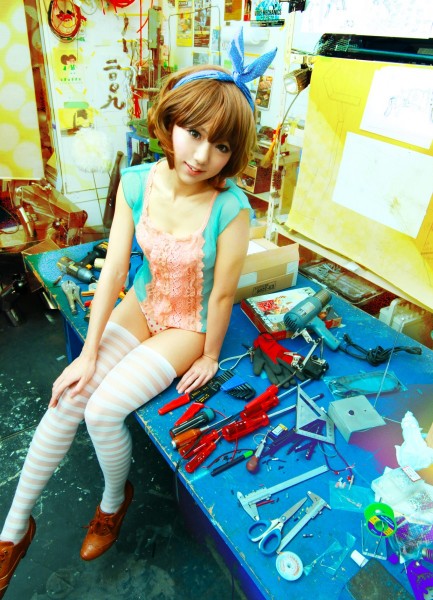
Photographer, Model: Julie Watai Location: KIMURA Workshop/2011 Shoot
撮影、モデル Julie Watai ロケ地 KIMURA工房 /2011年撮影
Julie: I agree; the Japanese attitude on sex is certainly unique. There aren’t many religious in Japan, even when it comes to Buddhism. So sex culture in Japan has been encouraged over a long period of time. In many other countries, sexual expression is limited due to religious rules and commandments.
Julie: 確かに日本の性風俗って独特ですよね。宗教も、仏教とは言っても熱心な人の方が珍しいくらいで。それも日本の性文化が育まれている原因かもしれない。多くの国では宗教による戒律で性的表現が制限されていたりするので、そういった要因もあるのかなって。
Etsuko: I think it’s because Japan wasn’t a country where Christianity had really taken root. There’s the theory that with the introduction of Christian views, Japan’s unique sexual culture and our sexuality have started to become viewed as “embarrassing”. But essentially, I think that carefree attitude towards sex still exists today, especially if you look at things like loli-e (sexual depictions of minors). (laugh) Shunga-like (pornographic woodblock prints) imagery still influences “painters” today.
市原えつこ: キリスト教っぽい戒律が、もともと根付いてなかった国なんですよね。キリスト教が輸入されたぐらいから、日本の独特の性文化や性に対するおおらかさが「恥ずかしいもの」という価値観が出てきた、という説もあるみたいです。でも元々、日本人のメンタリティとして、性に対しておおらかな部分は現代にも受け継がれているんじゃないかなと思います。ロリ絵とか観ていると(笑)。春画的なイメージは、現代の「絵師」さんの作品に受け継がれているのかも。
Julie: I agree when it comes to loli-e. It’s a big problem in some countries. I think precisely because we have a history of shunga that it’s something you still see on a regular basis. Speaking of which, not only do you have a birds-eye view of Japanese sex culture, but in representing that in your art, I personally feel like I get a feel for Japan’s future from artists like yourself.
Julie: ロリ絵は確かに。国によっては大問題ですものね。春画の歴史があるからこそ日常的に溶け込んでいるという背景があるんでしょうね。そう言った日本の性文化を俯瞰して捉えた上でアートとして表現するのが若い女性(市原さん)、というのも日本の未来を感じるな! と個人的に思っています。
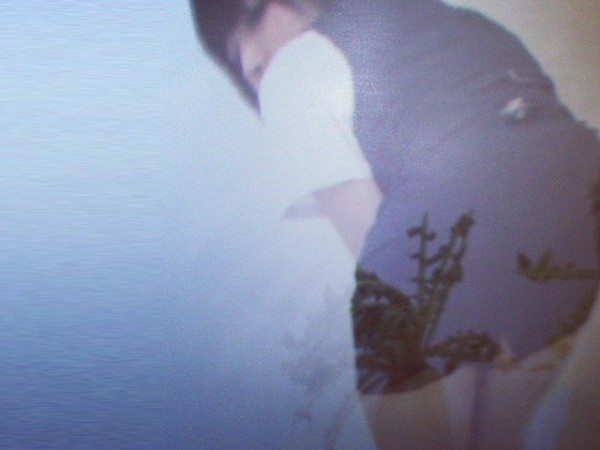
Delusion and Reality Alternating System SR×SI
妄想と現実を代替するシステムSR×SI
Julie: I’d like to change the topic a little, and ask you a little more about your work. Although I haven’t had the chance to try out your “Delusion and Reality Alternating System SR×SI” system yet, just watching the video for it got me really excited!
Julie: 話が変わりますが、再び市原さんの作品の話を聞かせて頂きたいのですが。「妄想と現実を代替するシステムSR×SI」ですが、私こちらはまだ体験できていないのですが、動画で見てすごくドキドキしたんですが!
Etsuko: Oh!!!
市原えつこ: おお!!!
Julie: What did the guys who tried it out think about it?
Julie: 実際に体験した男性の感想はいかがでした?
Etsuko: They were pretty excited, lol. I had everyone fill out a questionnaire afterward, and 80% said they were pretty aroused, while 20% said they were very aroused.
市原えつこ: あれは、とてもみなさんドキドキされてますねw 体験者にアンケートをとっていたのですが、「非常に興奮した」が2割、「かなり興奮した」が8割。
Julie: lolololol
Julie: wwww
Etsuko: There were five different feedback ratings, and mostly everyone gave it a high marks.
市原えつこ:5段階評価で、だいたい高得点でした。
Julie: They must have felt really aroused, then! Were there any reactions from men afterward that stood out?
Julie: やっぱりみんな興奮してるね! 体験を終えた後の男性の様子で印象的だった方とかいらしゃいました?
Etsuko: After we took down the head-mounted display when the trial run was finished, there was one disappointed guy who sank to the floor like, “Nooo…”
市原えつこ: ヘッドマウントディスプレイを体験後に脱いでいただいた後、「あーーー……」って言いながらその場にへたりこんだ男性がいらっしゃいましたね。
Julie: Wow!!
Julie: なんとそこまで!!
Etsuko: He really broke out in a sweat! We had women try it, too, and they said they could get a sense for what boys feel when they’re going through puberty.
市原えつこ: とても汗をかいていました! ちなみに女性も体験してくださったことがありましたが、「思春期の童貞の気持ちがわかった」そうです。
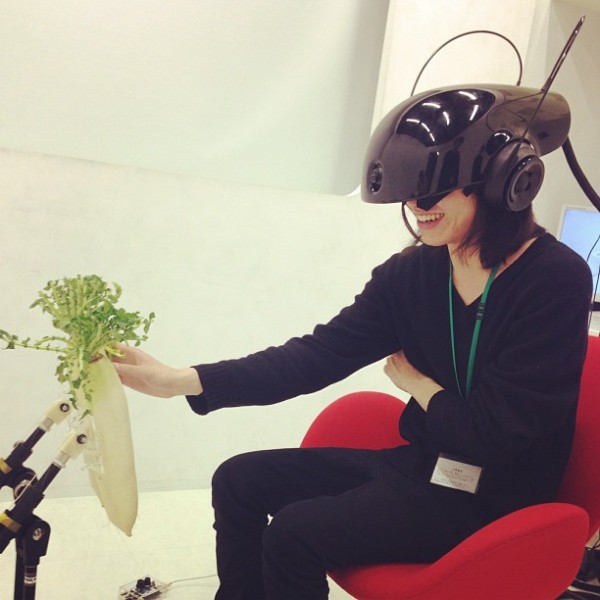
Julie: I’m a little envious they got such a good workout. But it must have been pretty embarrassing when you consider how other people were watching. (laugh) I’m curious to know what people were feeling while they were experiencing the SR×SI. I bet everyone felt something different. I got a good laugh at the lady in the picture, who was feeling up a radish thinking it was a thigh.
Julie: いい汗かいて羨ましい。しかし他人が見ている中だと結構恥ずかしかったでしょうね(笑)。このSR×SIの体験を通してみなさんどんな気持ちになったのかが気になりますね。それぞれ感想が違うんだろうなあ。そして画面のお姉さんに誘われて触っているはずの太ももが大根という現実とのギャップにも笑えました。
Etsuko: I think you’re right. While what they’re seeing is the same, depending on that person’s life experience it seems like they feel a variety of different things. I’m glad you could see the humor in what people inside the experiment are experiencing and what people outside of it see! While the person in the experience thought they were touching a girl’s thigh, you could see onlookers standing around and grinning cheekily. There’s also a kissing scene, but at the same time they’re actually putting their lips on a wet marshmallow.
市原えつこ: そうですね。作品の体験としては一緒なのですが、その人の人生経験によって見え方が変わる傾向はあるので、感想はみなさん多種多様でした。画面の中と外のギャップのひどさがポイントなので、笑って頂けてうれしいです! 本人はお姉さんのナマ足をさわれて幸せなのですが、外から見ると大根を触ってニヤニヤしているあやしいヤツになるという。この作品ではキスシーンもあるのですが、それは実際にはマシュマロを湿らせて画面のお姉さんと同じタイミングで唇につけています。
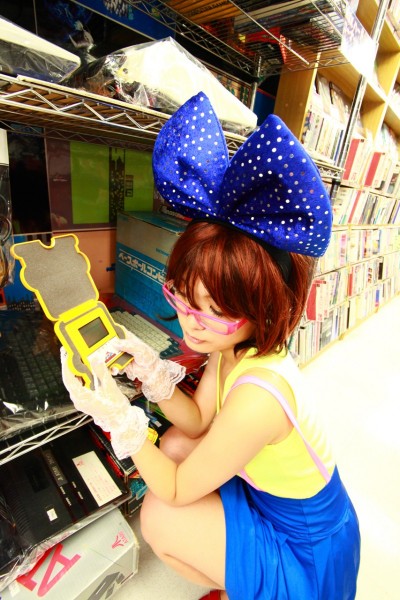
Photographer: Julie Watai Model: Haruna Kozoe Location: Super Potato Akihabara / 2011 Shoot
撮影 Julie Watai モデルはるな梢 ロケ地 スーパーポテト秋葉原店 /2011年撮影
Julie: In the near future, if adult-themed games with headphone mounted displays become more widespread, those who have them on might do the same strange things…!
Julie: 近い未来、ゲームのヘッドマウントディスプレイがギャルゲーで一般層にも広まったら、それを装着して同じように怪しい動きをする人たちが出てくるんだろうな……!
Etsuko: I’d like to make that happen. (laugh) There’s a lot of dystopian-like imagery associated with the future of technology, but it can also be amusing. In the future people will be able to be happy on their own.
市原えつこ:絶対出てくると思います(笑)。未来のテクノロジーのユートピアに隠れたディストピア的なイメージを、笑いに包みながら表現する、という隠れた意図もありました。みんながひとりで幸せになってる未来。
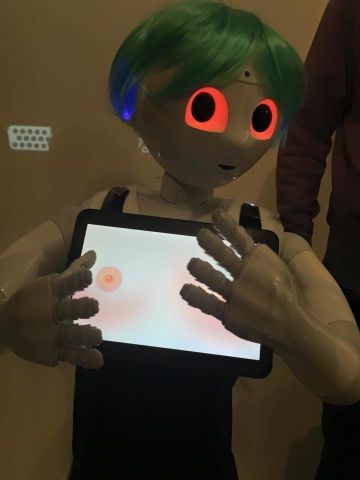
ペッパイちゃん(PEPPAI-CHAN)
Julie: When you unveiled your work PEPPAI-CHAN, it really got people on the net talking.
Julie : そして次に発表された作品が「ペッパイちゃん(PEPPAI-CHAN)」ネットでも話題騒然となっていましたね。
PLEASE Watch PEPPAI-chan’s video on Nico Nico Douga : http://www.nicovideo.jp/watch/sm26025677
Etsuko: Oh, PEPPAI-CHAN…! Yes, it made waves for a number of reasons. We took a household robot and mounted a tablet on her chest displaying breasts, and when someone would touch her she would make heavy breathing noises.
市原えつこ: あぁ、ペッパイちゃん……!はい、色んな意味で話題騒然となった作品でした。家庭用ロボットの胸部タブレットにおっぱいを表示して、触るとロボットがめちゃくちゃ腰をくねらせながら喘ぐ作品ですね。
Julie: When I saw it on Twitter I was worried about the negative comments left by people who didn’t understand your intentions behind it, but because of that it became an international sensation. People wouldn’t normally think to put a tablet showing breasts on a robot’s chest like that! (laugh)
Julie: 作品の意図を汲めなかった人たちからの誹謗中傷もあってTwitterを見た時に私も心配でしたが、それだけ世間的に話題になった作品でしたね。ちょうどロボットの胸部にタブレットがくるからおっぱいを表示させようなんて普通考えつかないですよ!(笑)
Etsuko: I think so, too. It was something I was motivated to make while caught up in the enthusiasm of a development event, and I had no idea it would get so much attention. Perhaps they were able to project the same feelings they have towards others onto the human-like robot. Oh, and whenever someone fondled her breasts too much, PEPPAI-CHAN would sound an alarm as she shook off the offending hand, and there was also a function that would tweet a picture of the person as well as their age and gender, but this had some pros and cons to it when it came to privacy issues, lol…
市原えつこ: そうですね。開発イベントで勢いで制作したものだったので、こんなに話題になるとは当初は読めませんでした。人型ロボットに対する世間の注目度と、人型のものに対して感情移入する人間の気持ちを感じたかも。ちなみにおっぱいを触りすぎるとペッパイちゃんが警報をならしながら怒って手を振り払い、おっぱいを触った人の写真と年齢、性別をTweetする機能もあるのですが、こちらも賛否を呼んだようですw プライバシー的な意味で……。
Julie: Well, um, well you shouldn’t be over doing it, then! (laugh)
Julie:うむ、やりすぎはよくない(笑)。
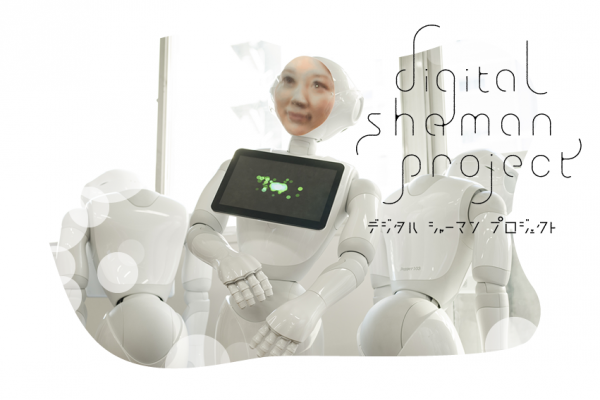
DIGITAL SHAMAN PROJECT
Julie: Then there’s your DIGITAL SHAMAN PROJECT. This is your most recent work, right?
Julie: そして「DIGITAL SHAMAN PROJECT」。こちらが最新の作品ですよね。
Etsuko: It is! It’s still relatively new, and I’m in the process of developing it now.
市原えつこ: はい! 新作であり、まだ発展途上の作品でもあります。
Julie: The video was really well done, and the story really had me going until the end. It made me think about a lot of different things.
Julie: 動画が本当によくできていて、ストーリー性もあり最後まで食い入って見てしまいました。いろいろと考えさせられましたよ。
Etsuko: Wow, I’m really glad to hear that! I have the support of the Cultural Affairs Agency’s Media Art Creator Development Assistance Program to thank for that, where a video director named Mr. Takai did me a big favor. This time around with the video we tried to evoke not feelings of laughter or sadness, but ones that were more ambiguous. Their changes depend on the person’s perception. A person who had lost someone close to them said that these kinds of hazy feelings had really helped, which was really moving for me.
市原えつこ: うわー、嬉しいです!あれは文化庁の「メディア芸術クリエイター育成支援事業」のご支援のおかげで、高井さんという映像ディレクターさんにお願いすることができました。今回はあえて、笑いとも悲しみともとれない、曖昧な感情を喚起させることにトライしました、映像は。人によって捉え方がいろいろ変わりそうですね。親しい方を亡くした方が、「モヤモヤした気持ちが救われた」と言ってくださったのは感動しました。
Julie: Pepper-kun is wearing a mask of your deceased grandfather, isn’t he? That alone makes him feel different from his usual appearance.
Julie: Pepperくんが亡くなったおじいちゃんの顔のマスクをつけているじゃないですか。それだけでもうPepperくんじゃなくなるんだろうなぁ、とか。
Etsuko: That’s right. That’s because face has a strong element of power to it. It has the power to erase the previous conceptions about Pepper-kun’s character. Initially I was just going to speak about the deceased using words, but then I realized that traces of it left on the body would prove powerful than the content of a message, and so it turned into this instead!
市原えつこ: そうですね。顔、という要素の持つ力はすごく強いので。Pepperくんの元々持っているキャラクターをかき消すぐらいの力がありました。初めは、単に亡くなった方っぽい台詞を喋らせる感じにしようと思ったんですが、メッセージの内容よりも、身体の痕跡のほうがずっと強い! ということに気がついて、今の形になりました。
Julie: Hearing you say earlier that it’s “easy for people to transfer their feelings to something of human form” really got me thinking about this video. It’ll run during a time limit for 49 days, after which the mask will finally come off. I think that perhaps there’s a lot of people who can’t accept the reality of losing someone close to them. But it would be really helpful if there were a service like this.
Julie: さっき仰った「人型のものに感情移入しやすい」っていう部分は、この動画では本当に考えさせられましたよ。49日のタイムリミットまで稼働していて最後にマスクがコトンと外れるという仕組みにもほろっときました。多分親しい人が亡くなってもなかなかその事実を受け入れられないかもしれない。でもこんなサービスがあったら救われるかもって。
Etsuko: I think so. Not everyone has the chance to say a proper farewell. In particular, I think there are many cases where someone passes away during a natural disaster, and in instances like these, I think it’s better to have a grace period like this. 49 days is a number that is familiar to Buddhism, but I think it was originally well thought out.
市原えつこ: そうですね。いつもお別れをちゃんと告げられるとは限らないので。特に日本だと災害も多くて、突然死のケースも多いと思うので、そういう時に猶予期間を設けるための仕組みがあるといいんじゃないかなと思いました。49日、という期間は仏教の制度に寄り添っているのですが、これも非常にうまく設計されていると思います。もともとが。
Julie: Yeah. 49 days seems like enough time to get a handle on your feelings. I think every family should have one. I’d love to have a set of them!
Julie: うん。49日あったら自分的にも気持ちの整理がつきそうですよね。この作品は一家に一台ものだと思います!全部セットで欲しいくらい!
Etsuko: Each family having one would be really ideal! Before everyone family has their own robot, I’d like to come out with a “Ghost Store” selling different people’s personalities. I could probably get quite a lot selling the personalities of different celebrities. (laugh)
市原えつこ: 一家に1台ある世界、いいですね! ロボットが一家に1台の時代になる前に、いろんな人の人格を販売できる「ゴーストストア」みたいなものをリリースしたいなと思っています。芸能人の人格、高く売れそう(笑)。
Julie: The name Ghost Store sounds pretty cool! I think it would do well internationally!
Julie: ゴーストストア、ネーミングもかっこいいですね!それ絶対世界中で流行りそうです!

Photography: Julie Watai Model: Hinami-chan Location: Kanasuke Workshop (Figure Prototype Instructor) / 2013 Shoot
撮影 Julie Watai モデル 悲なみちゃん ロケ地 かなすけ工房(フィギュア原型師)/2013年撮影
The spiritualism and humanism evident at the background of Etsuko’s work, after hearing it explained through her own words, leaves us with a lot of questions to ponder. Feelings and that which we can’t see plants fear inside us, which can’t be measured physically and is something strange that remains hidden inside of us. I believe every day Etsuko is exploring the possibilities of this unknown field, which lies at the root of our humanity.
市原さんの作品の背景にあるスピリチュアリズムやヒューマニズムは、彼女の視点で徹底的に分析された後に、私たちに与えられ問いかけてくる。目に見えない世界や感情は時に恐怖心を植え付けられる、物量で測れないものは得体の知れない恐ろしさを秘めているからだ。市原さんは人間の根本でもある未知の分野への可能性を日々探索、研究しているのだと思う。
At a first glance, her latest technology has a certain factor of entertainment to it, but feels familiar even to those who aren’t well versed in the field. However, once they experience the trip it takes them on and the spirit world the lies there, it sets everything into motion. I wonder if they realize that in her mind, we are all deep laboratory tables to be used for research.
一見して、エンターテイメント性に包まれた装置となって差し出される最新テクノロジーは、その分野に詳しくはない人でも親しみやすく簡単に受け入れられる。しかしひとたび体験するとそこからは精神世界の深淵へと、転がり落ちてしまう。我々は市原さんによる底知れない研究の実験台となっている事に気づかされるのだろう。
Related links
Etsuko Ichihara official site : http://etsukoichihara.tumblr.com/
Etsuko Ichihara Twitter : https://twitter.com/moja_etsuko
Julie Watai official site : http://juliewatai.jp/
Read more articles TOKYO CUTTING-EDGE CREATORS by Julie Watai
#2 : The Future of Fashion with Junya Suzuki from “chloma”
chloma 鈴木淳哉と語る、ファッションの未来
http://tokyogirlsupdate.com/tokyo-cutting-edge-creators-chloma-20160488332.html
#1 : #1 : Past and Present of Akihabara with Ai☆Madonna
愛☆まどんなと語る、秋葉原カルチャーの過去と現在
http://tokyogirlsupdate.com/tokyo-cutting-edge-creators-ai-madonna-20160383506.html
Translated by Jamie Koide
Sponsored Links

NMB48’s Sayaka Yamamoto Keeps Her Chin Up as She Says Farewell to AKB48’s Team K

Risa Satosaki Reveals Everything in the MV for “S!NG”!



